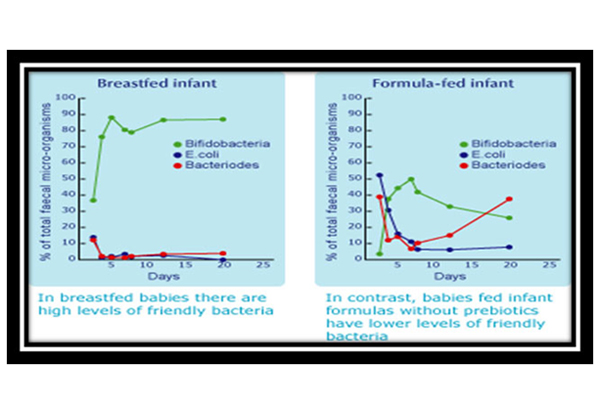Gut Flora in Breast Fed vs Formula Fed Babies

Leading Pharmaceutical consultant and editor-in chief of IJMToday



Dysbiosis is the abnormal microbial colonization of the intestine , where changes in Quantity and Quality of flora become Pathological & Harmful
Common causes of dysbiosis:
- Antibiotic therapy
- Autoimmune conditions , IBD
- Others are fast paced lifestyle, stress, food habits, Alcohol intake and cigarette smoking
Nutraceuticals
The term “Nutraceutical” was coined from “Nutrition” & “Pharmaceutical” in 1989 by Stephen De Felice.
Nutraceutical can be defined as
“ A food or part of food or nutrient, that provides health benefits, including the prevention and treatment of a disease.”
Includes :- GE foods, cereals supplemented with vitamins or minerals, genetically manipulated soybean and canola oil without trans-fatty acids
Classification of nutraceuticals
Based on chemical constituents:
- Nutrients :- Substances with established nutritional functions, such as vitamins, minerals, amino acids and fatty acids
- Herbals :- Herbs or botanical products as concentrates and extracts, such as aloe vera juice, evening primose oil
- Dietary Supplement :- products that contain a dietary ingredient intended to add something to the foods we eat such as prebiotics, probiotics
- Defining a probiotic“Live microorganisms which when administered in adequate amounts confer a health benefit on the host” (WHO)
Key properties of probiotic
- Non-pathogenic, non-toxic and non-allergic.
- Capable of surviving and metabolizing in upper G.I. tract e.g. Resistant to low pH, organic acids, bile juice, saliva and gastric acid
- Human in origin, genetically stable and capable of remaining viable for long periods in field condition.
- Able to modulate immune response and provide resistance to disease through improved immunity or by the production of antimicrobial substance in the guts.
- Good adhesion/ colonization to human intestinal tract and influence on gut mucosal permeability.
- Antagonistic against carcinogenic/ pathogenic organisms.
- Clinically proven health benefit, e.g. gastrointestinal disorders, diarrhea, clostridium difficle colitis, antibiotics associated diarrhea, acute gastroenteritis.
- Technologic properties for commercial viability such as stability of desired characteristics during processing, storage and transportation
Mechanism of action
- Bioconversion of, for example, sugars into fermentation products
- Production of growth substrates, like vitamins B and K, for other bacteria
Direct antagonism by antimicrobial substances:
- hydrogen peroxide
- organic acids
- Bacteriocin
- acidophilin
- Competitive exclusion for binding sites
- Improved barrier function
- Production of β- D- galactosidase enzymes that break down lactose .
- Reduction of inflammation, thus altering intestinal properties
- Stimulation of innate immune response
Foods containing Probiotics
- Milk
- Soya milk
- Tofu
- Milk products- Sour cream, Butter milk, Yoghurt
Fermented Indian foods like
- Idlis
- Dosas, uttapam
- Dhoklas
- Vadas
- Kadhi
- The concept of prebiotic was introduced by Gibson & Roberfroid, in 1995
- “Non-digestible food ingredients that beneficially affect the host by selectively stimulating the growth and/or activity of one or a limited number of bacteria in the colon that can improve host health.”
Prebiotics- examples
- Garlic, Onions
- Chicory root
- Asparagus
- Wheat
- Rye , Barley
- breast milk
- tomatoes, berries
- bananas
| Name | Obtained from/manufactured by |
|---|---|
| Inulin | Extraction from chicory root, Wheat, Banana, Onions, Garlic, Leek |
| Fructo-oligosaccharides | Tranfructosylation from sucrose, or hydrolysis of chicory inulin |
| Galacto-oligosacchaides | Produced from lactose by b-galactosidase, Milk |
| SOS (soy-oligosaccharides | Extracted from soya bean whey |
| XCOS (xylo-oligosucharides) | Enzymic hydrolysis of xylan |
| MAO (isomalto oligosacchmides) | Transgalaaosylaion of maltose |
| Pyrodextrins | Pyrolysis ofpotato or maize starch |
Breast Milk Oilgosachharides – They represent the third largest component of Human Milk 20 – 23 gm/l in colostrum & 12 – 14 gm/l in mature milk.
Clinical application of probiotics and prebiotics Proven Benefits
- Diarrheal Illness – treatment and prevention
- Prevention of antibiotic-associated diarrhea (AAD)
- Treatment of Clostridium difficile infection
- Inflammatory bowel disease (ulcerative colitis,CD)
- Lactose intolerance
- Necrotizing Enterocolitis (NEC)
Suggested Benefits
- Food allergies
- Eczema
Holds Promise
- Allergic rhinitis
- Asthma
- Colic
- Colon cancer prevention
- Obesity
- Hypertension
- In elderly
- Cystic fibrosis
- Dyslipidemia/ Cardiovascular diseases
- Rheumatoid arthritis
- Traveller’s diarrhea / bacterial enteritis
- Genitourinary tract infections
Probiotics in the Treatment of Gastrointestinal Disorders
- Diarrhea
- Acute infectious
- Antibiotic-associated
- C. difficile
- H. pylori Eradication
- Lactose Intolerance
- Constipation
- IBD
- Ulcerative colitis
- Crohn’s disease
- Pouchitis
Antibiotic associated diarrhea
- Disease
- Antibiotic treatment
- Probiotics
- Disturbance of intestinal microbiota
- Microbiota in balance
- Clostridium overgrowth produces toxin
Lactose intolerance
- Lactase digests lactose commonly present in milk and milk products.
- Lactose is not digested when there is a deficiency in lactase and results in diarrhea.
- Supplementation with probiotics has been shown to mitigate the symptoms of lactose intolerance by enzyme β- D- galactosidase.
- Having yoghurt is a good way for a lactose intolerant person to get calcium.
Helicobacter pylori Infections
- Chronic gastritis, Peptic ulcers, Gastric adenocarcinoma, and a number of non-gastrointestinal disorders.
- Bifidobacteria and B. subtilis may inhibit the growth or attachment of H. pylori.
- Possible mechanisms eradicates H. pylori include
- the ability of the probiotics to bind to gastric epithelial cells,
- to produce a high quantity of lactic acid, and
- to proliferate rapidly.

Probiotics and Cancer
Enzymes (Glycosidase, B- glucuronidase , azoreductase , and nitroreductase) of the intestinal flora convert the precarcinogens to active carcinogens giving rise to colon CA. Probiotics reduce
- Faecal concentrations of enzymes
- Reduce absorption of harmful mutagens that may contribute to colon carcinogenesis.
- Activity of L. acidophilus and L. casei supplementation in humans helps to decrease levels of these enzymes

Dosage of Probiotics
- The dose of probiotics is usually expressed as the number of colony forming units (CFUs).
- Due to the multitude of strains, the FDA has not approved any specific health claims for probiotics. The varying strains also make it impossible to establish an RDA for a probiotic.
- Probiotic effects should be considered dose-specific
- Dose listed on the label are based on studies that show a beneficial health effect in humans.
Prebiotics vs Problotics
| Prebiotics | Probiotics |
|---|---|
| Prebiotics are defined as nonliving non• digestible special form of fiber or carbohydrates. | Probiotics are referred to as live active microorgeniems tb,. when administered in adequate amount will have beneficial effects to its host. |
| The powder form of prebiotics can survive heat, cold, acid | more fragile. vulnerable to heat. may be killed over time |
| Prebiotics perform their role by nourishing the bacteria that live M the intestines | Probiotics fight the harmful bacterial species present in she gut. |
Adverse effects
- Probiotics side effects, if they occur, tend to be mild and digestive symptoms. (such as gas or bloating).
- May cause infections, especially in immuno- compromised patients.
- Diabetic patients should be doubly cautious about taking probiotic drinks available in the market as they contain high level of sugar.
- Probiotic products taken as a dietary supplement are manufactured and regulated as functional foods, not drugs
Are probiotics supplements necessary?
- Probiotics supplements are not necessary for normal, healthy individuals.
- • In healthy individuals, daily consumption of probiotics rich foods, particularly fermented dairy products like yoghurt adequately supplies the amount of probiotics required to maintain a healthy digestive system and overall wellbeing.
- A diet high in starches and fibre provide prebiotics, which keep a healthy population of probiotics in our intestines.
Synbiotics
Synbiotic = Probiotic + Prebiotic
The concept of synbiotics has been proposed to characterize health-enhancing foods and supplements used as functional food ingredients in humans
Potential synergy between pro- & prebiotics
Improve survival in upper GIT
More efficient implantation
Bifidobacteria and fructo-oligosaccharides (FOS)
Health benefits of Synbiotics
- Improved survival of live bacteria in food products, prolonged shelf life
- Increased number of ingested bacteria reaching the colon in a viable form
- Stimulation in the colon of the growth and implantation of both exogenous and endogenous bacteria
- Activation of metabolism of beneficial bacteria, antagonistic toward pathogenic bacteria




